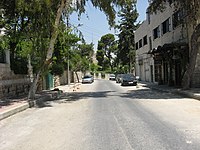
Amman is the capital and the largest city of Jordan, and the country's economic, political, and cultural center. With a population of 4,061,150 as of 2021, Amman is Jordan's primate city and is the largest city in the Levant region, the fifth-largest city in the Arab world, and the ninth largest metropolitan area in the Middle East.

Sa'id Pasha al-Mufti was the 9th Prime Minister of Jordan and a Jordanian political figure of Circassian origin. Said Pasha received Emir Abdullah with a few Jordanian Sheikhs, when he came to Jordan and was leading the Great Arab Revolt against the Ottoman rule.

The Beirut Central District (BCD) or Centre Ville is the historical and geographical core of Beirut, the capital of Lebanon. Also called downtown Beirut, it has been described the “vibrant financial, commercial, and administrative hub of the country.” It is thousands of years old, traditionally a focus of business, finance, culture and leisure.
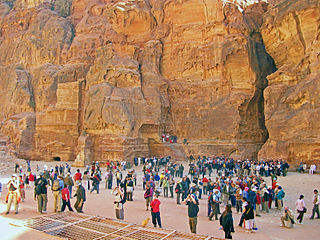
Jordan is a sovereign Arab state in the Middle East. The capital, Amman, is Jordan's most populous city as well as the country's economic, political and cultural centre.
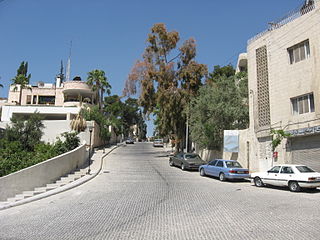
The Rainbow Street, originally named Abu Bakr al Siddiq street, is a public space in the historic area of Jabal Amman, near the center of downtown Amman, Jordan. The street runs east from the First Circle to Mango Street, and contains several attractions from roof top restaurants to pubs. The street runs in front of the British Council building, as well as the headquarters of the Jordan Petroleum Refinery Company and the cinema after which the street is renamed.

Mango Street is a historic street in the Jabal Amman area near downtown Amman, Jordan. Officially named Omar bin al-Khattab Street, the street derives its nickname from the Mango House, a building on the intersection between Mango and Rainbow Streets. Mango Street has an assortment of historic buildings, many being Ottoman, and across the street from the Mango House is Al-Mufti House. Books@Cafe and other locations such as Old View Cafe line the street.
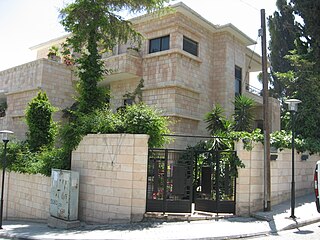
The Mango House is a building in Amman, Jordan. Situated on Mango Street, the house looks out toward Jabal Akhddar on the other side of the valley that is downtown Amman.

The Mufti House is a house located on Rainbow Street-Mango Street intersection in the Jabal Amman neighbourhood of Amman, Jordan. Like many other houses in Jabal Amman, such as the Mango House across the street, 70 years has given the Mufti House time for a significantly wooded front yard to develop. A stair-stepped stone wall covered in ivy separates it from the main street.
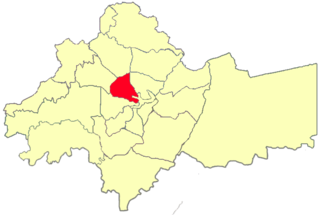
Abdali is an area in the Greater Amman Municipality, it is named relative to King Abdullah I who founded it during the 1940s. It covers an area of 15 square kilometres (6 sq mi) in the heart of Amman, with a population of 165,333 in 2015. Large parts of the district are residential, but due its geographical location in the center of the city, it contains several important governmental buildings and businesses. The area is known for containing several bus stations serving routes to many cities in Jordan.

The Amman Citadel is an archeological site at the center of downtown Amman, the capital of Jordan. The L-shaped hill is one of the seven hills (jabals) that originally made up Amman.

Downtown Amman is an old, central commercial area of Amman, Jordan.

The "Jordan River Foundation" was founded earlier by Queen Nour Al Hussein, the wife of the late king of Jordan Hussein bin Talal, after the death of king Hussein, queen Nour left her position as the Chair person of "Jordan River Foundation" and the new queen Rania took over the position. The Jordan River Foundation is a Nonprofit organization started back in the early nineties( sometime after 1990) Amman, Jordan to empower society, especially women and children, and in turn, improve the quality of life to secure a better future for all Jordanians. The foundation was founded by and is chaired by queen Nour Al Hussein and then chaired by Queen Rania Al-Abdullah.
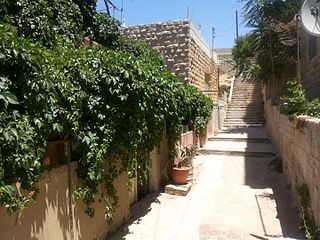
Armenians in Jordan are ethnic Armenians living in the Hashemite Kingdom of Jordan. There are an estimated 3,000 Armenians living in the country today with an estimated 2,500 of them being members of the Armenian Apostolic Church, and predominantly speak Western Armenian dialect. Armenians make up the biggest majority of non-Arab Christians in the country.

Beirut Souks is a major commercial district in Beirut Central District. With over 200 shops, 25 restaurants and cafes, an entertainment center, a 14 cinema complex, periodic street markets and an upcoming department store, it is Beirut's largest and most diverse shopping and leisure area. Beirut Souks also features piazzas and public space. Designed in five separate commissions by international and Lebanese architects, Beirut Souks offer 128,000 sq. m of built-up area interspersed with landscaped pedestrian zones.
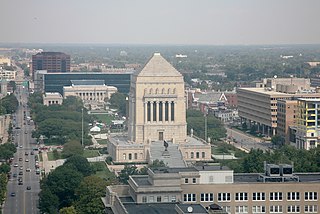
Meridian Street is the primary north–south street in Indianapolis, Indiana.

Souk Jara is a market in Amman, Jordan founded in 2005. The Souk (market) is a major tourist attraction lying next to Rainbow Street in Jabal Amman, it features handicrafts, antiques, crafts, food, streetwear, art and traditional products from around the Kingdom. It is available on each Friday, between mid May to mid September from 10 am till 10 pm. Film screenings, concerts and other cultural activities are commonplace.

Zahran is an area in the Greater Amman Municipality. It is named after the Zahran Palace which stands amidst Zahran street. It consists of 5 neighborhoods of which most parts are residential, however, some parts of the district contain Amman's best hotels, hospitals and towers. The district is also home to several governmental buildings, embassies, cultural centers and schools. Zahran area stretches from 1st circle to between 5th and 6th circles, and from North Abdoun to South Abdoun.
Rami Daher is a Jordanian architect, academic, and public intellectual specializing in architectural conservation and urban design. He is currently an associate professor at the School of Architecture and Built Environment at the German Jordanian University and general director of TURATH, an architectural and urban design consultancy in Amman, which has executed several major interventions in historic and heritage settings.

Jabal al-Luweibdeh, also known as Jabal al-Weibdeh, is a neighborhood in Downtown Amman, Jordan.




